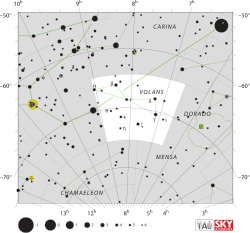Kappa Volantis

| |
| Observation data Epoch J2000.0 Equinox J2000.0 | |
|---|---|
| Constellation | Volans |
| κ¹ Vol | |
| Right ascension | 08h 19m 48.96447s[1] |
| Declination | −71° 30′ 53.6692″[1] |
| Apparent magnitude (V) | 5.37[2] |
| κ² Vol | |
| Right ascension | 08h 20m 00.52661s[1] |
| Declination | −71° 30′ 19.3664″[1] |
| Apparent magnitude (V) | 5.65[2] |
| Characteristics | |
| κ¹ Vol | |
| Spectral type | B9III/IV[3] |
| U−B color index | −0.31[2] |
| B−V color index | −0.06[2] |
| κ² Vol | |
| Spectral type | B9/A0IV[3] |
| U−B color index | −0.31[2] |
| B−V color index | −0.10[2] |
| Astrometry | |
| κ¹ Vol | |
| Radial velocity (Rv) | 36.0[4] km/s |
| Proper motion (μ) | RA: −16.89[1] mas/yr Dec.: +36.26[1] mas/yr |
| Parallax (π) | 7.50 ± 0.35[1] mas |
| Distance | 430 ± 20 ly (133 ± 6 pc) |
| κ² Vol | |
| Radial velocity (Rv) | −6.50[4] km/s |
| Proper motion (μ) | RA: −17.71[1] mas/yr Dec.: +34.10[1] mas/yr |
| Parallax (π) | 7.79 ± 0.21[1] mas |
| Distance | 420 ± 10 ly (128 ± 3 pc) |
| Details | |
| κ¹ Vol | |
| Luminosity | 129[5] L☉ |
| Temperature | 9,884[5] K |
| κ² Vol | |
| Luminosity | 124[5] L☉ |
| Temperature | 11,682[5] K |
| Other designations | |
| κ¹ Vol: CP−71° 677, HD 71046, HIP 40817, HR 3301, SAO 256497.[6] | |
| κ² Vol: CP−71° 678, HD 71066, HIP 40834, HR 3302, SAO 256499.[7] | |
Kappa Volantis (κ Vol, κ Volantis) is a triple star system in the constellation Volans. The primary component has an apparent visual magnitude of 5.37, while the secondary companion is magnitude 5.65.[2] based upon parallax measurements, the stars appear to be around 420−430 light years. from the Sun.
The brightest component, κ¹ Volantis, is a blue-white B-type star with a stellar classification showing characteristics ofa both a subgiant and giant star. Separated from κ¹ by 65 arcseconds, κ² Volantis is a white subgiant star that falls between a B-type and A-type classification. The system's third component, κ Volantis C, is a magnitude +8.5 star 37.7 arcseconds away from κ².
References
- 1 2 3 4 5 6 7 8 9 10 van Leeuwen, F. (2007), "Validation of the new Hipparcos reduction", Astronomy and Astrophysics, 474 (2): 653–664, arXiv:0708.1752
 , Bibcode:2007A&A...474..653V, doi:10.1051/0004-6361:20078357.
, Bibcode:2007A&A...474..653V, doi:10.1051/0004-6361:20078357. - 1 2 3 4 5 6 7 Johnson, H. L.; et al. (1999), "UBVRIJKL photometry of the bright stars", Commission Lunar and Planetary Laboratory, 4: 99, Bibcode:1966CoLPL...4...99J.
- 1 2 Houk, Nancy; Cowley, A. P. (1979), Michigan catalogue of two-dimensional spectral types for the HD stars, 1, Ann Arbor, Michigan: Dept. of Astronomy, University of Michigan, Bibcode:1978mcts.book.....H.
- 1 2 de Bruijne, J. H. J.; Eilers, A.-C. (October 2012), "Radial velocities for the HIPPARCOS-Gaia Hundred-Thousand-Proper-Motion project", Astronomy & Astrophysics, 546: 14, arXiv:1208.3048
 , Bibcode:2012A&A...546A..61D, doi:10.1051/0004-6361/201219219, A61.
, Bibcode:2012A&A...546A..61D, doi:10.1051/0004-6361/201219219, A61. - 1 2 3 4 McDonald, I.; et al. (2012), "Fundamental Parameters and Infrared Excesses of Hipparcos Stars", Monthly Notices of the Royal Astronomical Society, 427 (1): 343–57, arXiv:1208.2037
 , Bibcode:2012MNRAS.427..343M, doi:10.1111/j.1365-2966.2012.21873.x.
, Bibcode:2012MNRAS.427..343M, doi:10.1111/j.1365-2966.2012.21873.x. - 1 2 "kap01 Vol -- Star", SIMBAD Astronomical Database, Centre de Données astronomiques de Strasbourg, retrieved 2016-09-05.
- ↑ "kap02 Vol -- Star", SIMBAD Astronomical Database, Centre de Données astronomiques de Strasbourg, retrieved 2016-09-05.
This article is issued from Wikipedia - version of the 10/23/2016. The text is available under the Creative Commons Attribution/Share Alike but additional terms may apply for the media files.